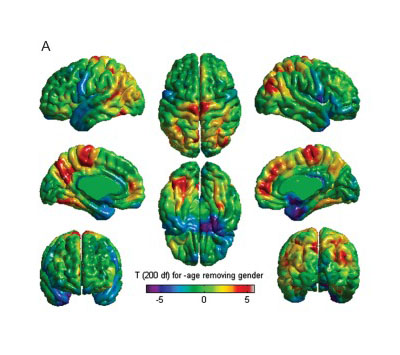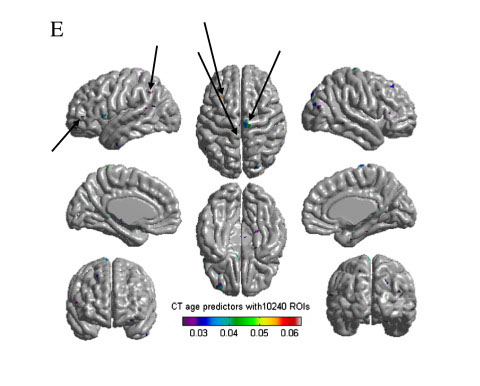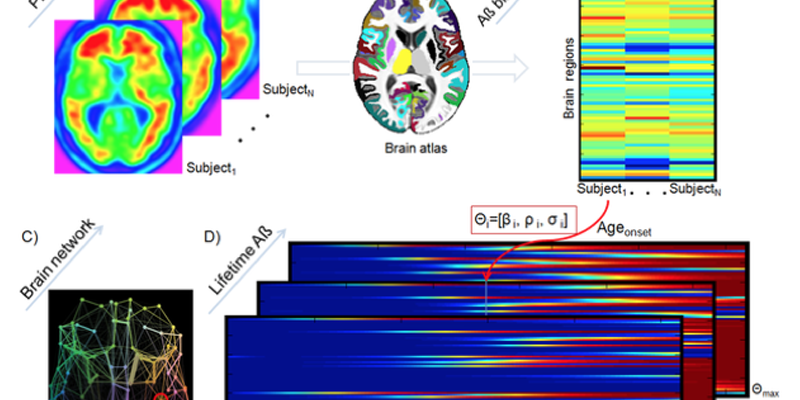
The Emergence of Network Inefficiencies in Infants with Autism Spectrum Disorder
Autism Spectrum Disorder (ASD) is a developmental disorder defined by behavioural features that emerge during the first years of life. Research indicates that abnormalities in brain connectivity are associated with these behavioural features.
Read More
Predicting symptom severity in autism spectrum disorder based on cortical thickness measures in agglomerative data
Machine learning approaches have been widely used for the identification of neuropathology from neuroimaging data. However, these approaches require large samples and suffer from the challenges associated with multi-site, multi-protocol data. We propose a novel approach to address these challenges, and demonstrate its usefulness with the Autism Brain Imaging Data Exchange (ABIDE) database.
Read More
Cortical Thickness Abnormalities in Autism Spectrum Disorders Through Late Childhood, Adolescence, and Adulthood: A Large-Scale MRI Study
Neuroimaging studies in autism spectrum disorders (ASDs) have provided inconsistent evidence of cortical abnormality. This is probably due to the small sample sizes used in most studies, and important differences in sample characteristics, particularly age, as well as to the heterogeneity of the disorder. To address these issues, we assessed abnormalities in ASD within the Autism Brain Imaging Data Exchange data set, which comprises data from approximately 1100 individuals (~6-55 years).
Read More
Imaging structural covariance in the development of intelligence
Verbal and non-verbal intelligence in children is highly correlated, and thus, it has been difficult to differentiate their neural substrates. Nevertheless, recent studies have shown that verbal and non-verbal intelligence can be dissociated and focal cortical regions corresponding to each have been demonstrated. However, the pattern of structural covariance corresponding to verbal and non-verbal intelligence remains unexplored.
Read More
Brain connectivity in normally developing children and adolescents
The developing human brain undergoes an astonishing sequence of events that continuously shape the structural and functional brain connectivity. Distinct regional variations in the timelines of maturational events (synaptogenesis and synaptic pruning) occurring at the synaptic level are reflected in brain measures at macroscopic resolution (cortical thickness and gray matter density).
Read More
Multivariate Analysis: Early role of vascular dysregulation on late-onset Alzheimer’s disease based on multifactorial data-driven analysis
To study multifactorial mechanisms underlying late-onset Alzheimer’s disease (LOAD) we examined 7,700 brain images and tens of plasma and cerebrospinal fluid biomarkers from the Alzheimer’s Disease Neuroimaging Initiative (ADNI).
Read More
Developmental changes in organization of structural brain networks
Recent findings from developmental neuroimaging studies suggest that the enhancement of cognitive processes during development may be the result of a fine-tuning of the structural and functional organization of brain with maturation. However, the details regarding the developmental trajectory of large-scale structural brain networks are not yet understood.
Read More
Prediction of brain maturity based on cortical thickness at different spatial resolutions
Several studies using magnetic resonance imaging (MRI) scans have shown developmental trajectories of cortical thickness. Cognitive milestones happen concurrently with these structural changes, and a delay in such changes has been implicated in developmental disorders such as attention-deficit/hyperactivity disorder (ADHD).
Read More
Mathematical Modeling: Epidemic Spreading Model to Characterize Misfolded Proteins Propagation in Aging and Associated Neurodegenerative Disorders
Misfolded proteins (MP) are a key component in aging and associated neurodegenerative disorders. For example, misfolded Amyloid-ß (Aß) and tau proteins are two neuropathogenic hallmarks of Alzheimer’s disease. Mechanisms underlying intra-brain MP propagation/deposition remain essentially uncharacterized. Here, is introduced an epidemic spreading model (ESM) for MP dynamics that considers propagation-like interactions between MP agents and the brain’s clearance response across the structural connectome.
Read More
Heritable changes in regional cortical thickness with age
It is now well established that regional indices of brain structure such as cortical thickness, surface area or grey matter volume exhibit spatially variable patterns of heritability. However, a recent study found these patterns to change with age during development, a result supported by gene expression studies. Changes in heritability have not been investigated in adulthood so far and could have important implications in the study of heritability and genetic correlations in the brain as well as in the discovery of specific genes explaining them.
Read More
Childhood cognitive ability accounts for associations between cognitive ability and brain cortical thickness in old age
Associations between brain cortical tissue volume and cognitive function in old age are frequently interpreted as suggesting that preservation of cortical tissue is the foundation of successful cognitive aging. However, this association could also, in part, reflect a lifelong association between cognitive ability and cortical tissue.
Read More
Network inefficiencies in autism spectrum disorder at 24 months
Autism spectrum disorder (ASD) is a developmental disorder defined by behavioral symptoms that emerge during the first years of life. Associated with these symptoms are differences in the structure of a wide array of brain regions, and in the connectivity between these regions. However, the use of cohorts with large age variability and participants past the generally recognized age of onset of the defining behaviors means that many of the reported abnormalities may be a result of cascade effects of developmentally earlier deviations.
Read More
Network efficiency in autism spectrum disorder and its relation to brain overgrowth
A substantial body of evidence links differences in brain size to differences in brain organization. We have hypothesized that the developmental aspect of this relation plays a role in autism spectrum disorder (ASD), a neurodevelopmental disorder which involves abnormalities in brain growth. Children with ASD have abnormally large brains by the second year of life, and for several years thereafter their brain size can be multiple standard deviations above the norm.
Read More
Callosal fiber length and interhemispheric connectivity in adults with autism: brain overgrowth and underconnectivity
Typical adults show an inverse relation between callosal fiber length and degree of interhemispheric connectivity. This has been hypothesized to be a consequence of the influence of conduction delays and cellular costs during development on axonal pruning, both of which increase with fiber length. Autism spectrum disorder (ASD) provides a test of this hypothesis: Children with ASD are known to have enlarged brains; thus, adults with ASD should show reductions in interhemispheric connectivity proportional to their degree of brain overgrowth during development.
Read More
